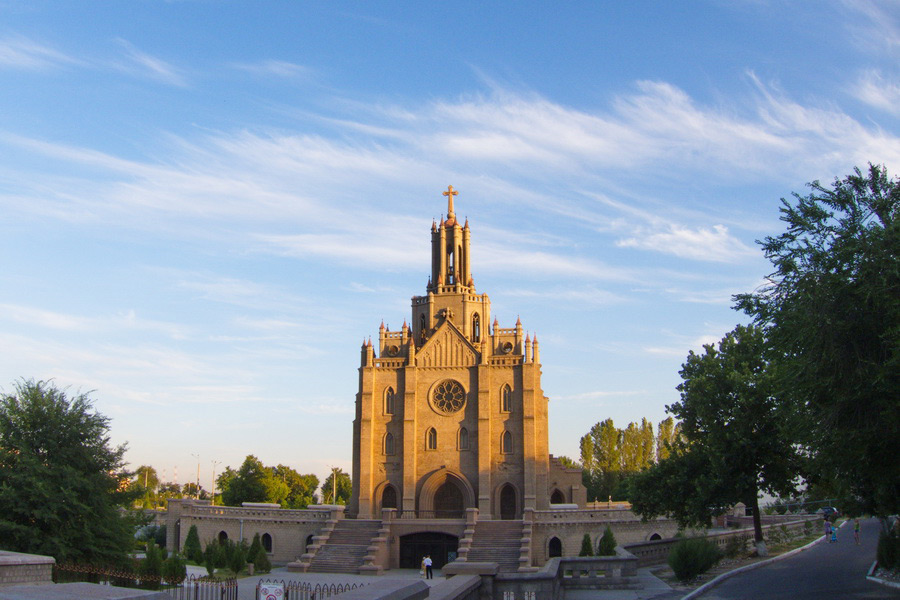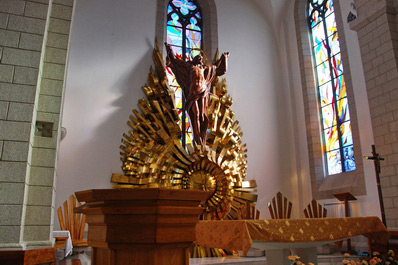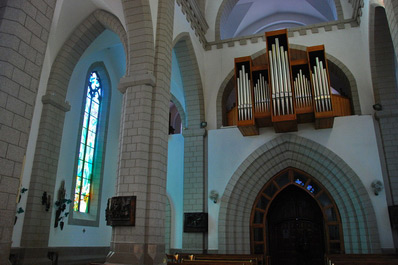The Roman Catholic Church of Tashkent

Address: 80/1, Tarakkiyot Str., Tashkent
Reference point: TashMI Clinic, Traumatology.
Christianity penetrates Central Asia in the first centuries AD with development of commercial ways of the Great Silk Road. Faith in the name of Christ was brought by mendicant friar and missioners, as well as by Christians them-selves, which had emigrated on this area after their oppressions in Syria and Persia.
Since the 12-13th centuries the catholic archdioceses and Eparchies are arisen along the Great Silk Road together with creation of diplomatic relations between the Holy See and China.
The next wave of the Catholicism relates to the II part of the XIX century and the beginning of the XX century. The number of Catholics in Turkestan exceeded 11 thousand in 1917. Mostly it was consisted of European nationalities occupying the region (Poles, Lithuanians, Czechs, Germans, French, Letts and Hungarians) among exiles, military men from the Tsarist Army, prisoners and refugees.
Since 1883 till 1885 Father Ferdinand Senchikovsky was the first official catholic priest of Turkestan region. Due to his efforts the first chapel for celebration of mass was opened in Tashkent.
Since 1902 till 1917 (up to his death) a Curate of Turkistan was father Justin Bonaventure Pranaitis, Professor of the Imperial Roman Catholic Academy in St. Petersburg, master of theology. It was just his efforts that contributed to the renewal of the catholic church in Tashkent. Under his guidance churches were built in Ashgabat, Kysyl Arvat (Turkmenistan), Ferghana, Samarkand, a temporary church-chapel was constructed in Tashkent, as well as con-struction of the currently existing cathedral had started. Father Pranaitis was a head of the Roman Catholic Charitable Society of Turkestan created by him; later, particularly during the First World War, the society organized shelters for orphans, old men and refugees.
Since 1917 till 1930 a successor of Pranaitis was vice-curate father Boleslav Rutenis who tried to finish the con-struction of the Roman Catholic Church of Tashkent; however, he had to leave his post under pressure of Soviet ide-ologists. He was a witness of the last period of existence of the catholic churches in Tashkent, Samarkand and Ferg-hana. Till 1937 father Joseph Sovinsky was a pastor of remaining parishioners, he secretly celebrated mass and catho-lic rites, but he was arrested under charge of counterrevolutionary agitation and shoot at the same year. Since that time the Catholics of Uzbekistan didn't have their churches and open parishes. A catholic church was registered in Ferghana only in 1987; in Tashkent it was also registered due to efforts of father Joseph Svidnicky in 1990.
Since 1991 till 2005 (with an interval 2001-2003) the head of the Roman Catholic Church of Tashkent was father Krzysztof Kukulka - Franciscan from Poland, assigned by father John Paul II, who was an ordinary of "Missio sui Ju-ris" in Uzbekistan. It was he who had not only to arise remaining fragments of uncompleted church of the capital from ruins but also to contribute into renaissance of the Catholicism in Uzbekistan: churches were opened again in Samarkand, Urgench and Bukhara, the restored building of the Roman Catholic Church under proclamation of the Sacred Heart of Jesus became one of the most famous centers of music culture, particularly after its consecration in 2000. Since 2002 due to the initiative of father Krzysztof the catholic information center "Agnuz" has started its operation.
On 1 April 2005 Holiest Father John Paul II advanced the status of "Missio sui Juris" in the Republic of Uzbekistan to Apostolic Administration and appointed Jerzy Maculewicz as its first bishop - General Assistant of the Order of Friars Minor Conventual - (OFM Conv.), Conventual Franciscans for Eastern Europe, Jersy Maculewicz had arrived to Uzbekistan from Rome. On 26 June 2005 Jerzy Maculewicz made his ingress (enter) to the church of Tashkent. There are 5 official parishes currently registered in Uzbekistan: Tashkent, Samarkand, Bukhara, Ferghana and Ur-gench; catholic priests and monastic Brothers-Franciscans as well as missioners of the Divine Love Order (sisters of Mother Teresa) permanently present in the Republic.



